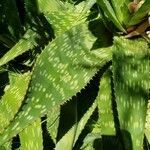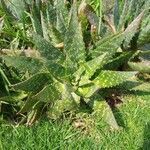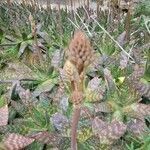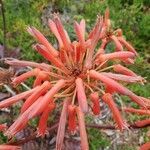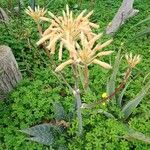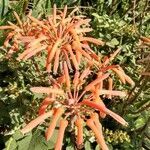Plants usually with very short stems, freely suckering, forming dense groups. Leaves 12–16, spreading to recurved, broadly lanceolate, 12–16 cm long; adaxial surface pale green with numerous white spots; abaxial surface pale green with dull white spots; margins with brown-tipped teeth 4–5 mm long. Inflorescence simple or branched, 40–80 cm tall; scape subtended by deltoid bracts 10 mm long. Racemes 1–3, condensed, 8–10 cm long, 10–14 cm wide; flowers crowded; bracts deltoid-acuminate, 7–10 mm long; pedicels 30–35 mm long. Perianth cylindrical-trigonous with basal swelling near ovary, 35–45 mm long, orange-pink; sepals and petals sub-acute to obtuse, spreading to recurved, cohering for part of their length. Stigma exserted 5 mm. Fruit not seen.
Succulent, perennial herb; acaulescent or stem up to 0.5 m long, rosettes solitary or suckering to form dense groups. Leaves with blade narrowly ovate to ovate, up to 250-300 mm long, with dried twisted apex; margins with pungent, deltoid, horny, brown teeth, pale to darker green, with many, dull, white spots in irregular broken, wavy, transverse bands on upper surface, paler green, obscurely lineate and usually without spots on lower surface. Flowers: inflorescence branched in middle, 0.4-1.0 m high, branches ascending, with capitate-corymbose, dense racemes; constricted above ovary; stamens and stigma exserted; perianth 35-45 mm long, red or orange to yellow; Jun., Jul. or Sep.-Jan.
Succulent, perennial herb; acaulescent or stem up to 0.5 m long, rosettes solitary or suckering to form dense groups. Leaves pale to darker green, with many, dull, white spots in irregular broken, wavy, transverse bands, adaxially paler green, obscurely lineate and usually without spots abaxially, narrowly to broadly lanceolate, up to 250300 mm long, with dried twisted apex, margins with pungent, deltoid, horny, brown teeth. Inflorescence branched in middle, 0.4-1.0 m high, branches ascending, with capitate-corymbose, dense racemes. Flowers red, orange or yellow; perianth with basal swelling, 35-45 mm long; stamens and stigma exserted. Flowering time June, July, Sept.-Jan.
A shrub. It does not have a stem. It grows in a ring. The main ring can be 40 cm tall. The leaves are thick and succulent and 25 cm long. There are sharp dark brown teeth along the edge. The leaves have white freckles. The flowers are tube shaped and red, orange or yellow.
